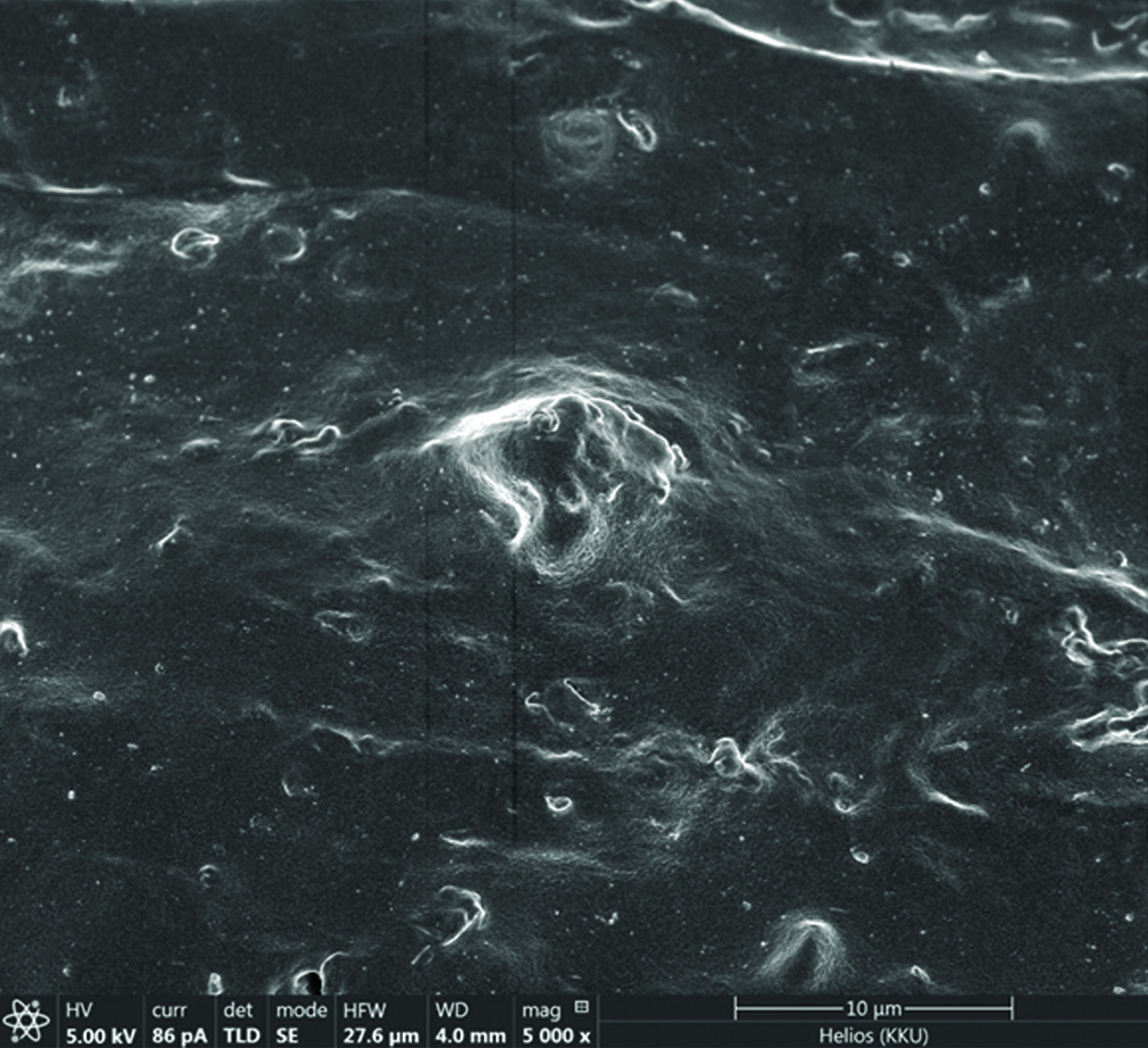Mechanical Properties of Natural Rubber Reinforced with Modified Silica by Admicellar Polymerization
Main Article Content
Abstract
Carbon Black (CB), Unmodified Silica (Si) and silica modified by admicellar polymerization (MS) were applied as rubber reinforcement. Mechanical properties of these different rubber formulae were subsequently tested. The results revealed that the mechanical properties of rubber reinforced with silica modified by admicellar polymerization were superior to those reinforced with carbon black or unmodified silica. As for the rubber reinforcement with silica modified by admicellar polymerization at the 40 phr (Parts Per Hundred of Rubber) mixture ratio with a compression mold at 160 kg/cm2 at a 145 °C cure temperature for 4 minutes proved to be the best mechanical properties effective and the most optimal conditions to be used as a rubber chemical formulae for production of inner rubber tube products.
Article Details
References
[2] Wu, J. H., Harwell, J. H., and O’Rear, E. A. (1987). Two-Dimensional Solvents: Kinetics of Styrene Polymerization in Admicelles at or Near Saturation. The Journal of Physical Chemical. Vol. 91, No. 3, pp. 623-634. DOI: 10.1021/j100287a027
[3] Thammathadanukul, V., O’Haver, J. H., Harwell, J. H., Osuwan, S., Na-Ranong, N., and Waddell, W. H. (1996). Comparison of Rubber Reinforcement Using Various Surface Modified Silica. Journal of Applied Polymer Science. Vol. 59, No. 11, pp. 1741-1750
[4] Nontasorn, P., Chavadej, S., Rangsunvigit, P., O’Haver, J. H., Chaisirimahamorakot, S., and Na-Ranong, N. (2005). Admicellar Polymerization Modified Silica Via a Continuous Stirred Tank Reactor System: Comparative Properties of Rubber Compounding. Chemical Engineering Journal. Vol. 108, pp. 213-218. DOI: 10.1016/j.cej.2005.02.016
[5] Kitiyanan, B., O’Haver, J. H., Harwell, J. H., and Osuwan, S. (1996). Adsolubilization of Styrene and Isoprene Into Cetyltrimethyl Ammonium Bromide Admicelle on Precipitated Silica. Langmuir. Vol. 12, pp. 2162-2168
[6] Alkassiri, H. (2005). Radiation Polymerization of Diethyl Fumarate. Radiation Physics and Chemistry. Vol. 73, Issue 1, pp. 61-63
[7] Cataldo, F., Ursini, O., and Lilla, E. J. (2008a). Radiation Induced Polymerization of Isoprene: A Spectroscopic Study. Journal of Radioanalytical and Nuclear Chemistry. Vol. 275, Issue 1, pp. 9-16. DOI: 10.1007/s10967-006-6981-2
[8] Cataldo, F., Ursini, O., Lillb, E., and Angelinib, G. (2008b). Radiation Induced Polymerization and Grafting of (-)pinene on Silica Surface. Radiation Physics and Chemistry. Vol. 77, Issue 5, pp. 561-570. DOI: 10.1016/j.radphyschem.2007.09.003
[9] Hayakawa, K., Kawase, K., and Matsuda, T. (1965). Gamma-Ray-Induced Polymerization of Some Vinyltin Compounds. Nature. Vol. 206, pp. 1038-1039. DOI: 10.1038/2061038b0
[10] Yaodong, L., Guozhong, W., Dewu, L., Mingying, Q., and Zhiyong, Z. (2005). 60Co -Irradiation Initiated Polymerization in Ionic Liquids the Eff ect of Carbon Chain Length of Monomer. Nuclear Instruments and Methods in Physics Research Section B. Vol. 236, Issue 1-4, pp. 443-448. DOI: 10.1016/j.nimb.2005.04.017
[11] Pongprayoon, T., Yooprasert, N., Suwanmala, P., and Hemvichian, K. (2012). Rubber Products Prepared from Silica Modified by Radiation Induced Admicellar Polymerization. Radiation Physics and Chemistry Journal. Vol. 81, pp. 541-546. DOI: 10.1016/j.radphyschem.2012.01.034
[12] Yooprasert, N., Pongprayoon, T., Suwanmala, P., Hemvichian, K., and Tumcharern, G. (2010). Radiation Induced Admicellar Polymerization of Isoprene on Silica: Effects of Surfactant’s Chain Length. Chemical Engineering Journal. Vol. 156, Issue 1, pp. 193-199. DOI: 10.1016/j.cej.2009.10.022
[13] Faklek, A. (2016). Development of Commercial Bicycle and Motorcycle Inner Tube Using Surface-Modified Silica. Thesis Master Degree of Engineering. Chemical Engineering. Faculty of Engineering. King Mongkut’s University of Technology North Bangkok.


